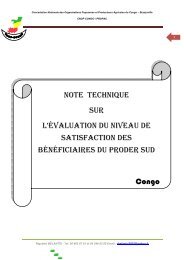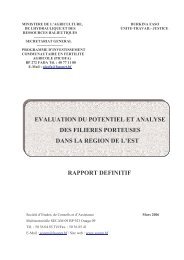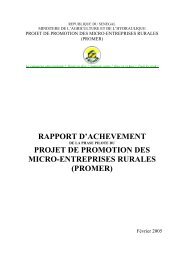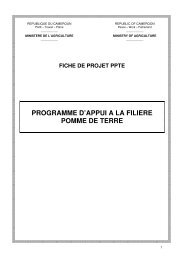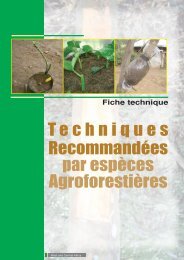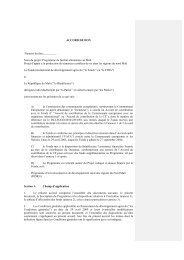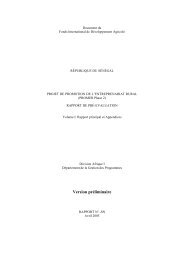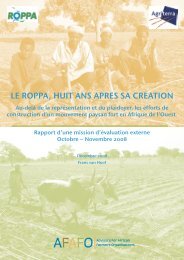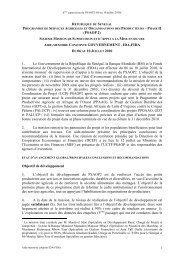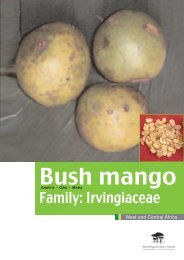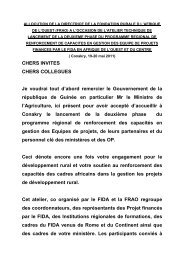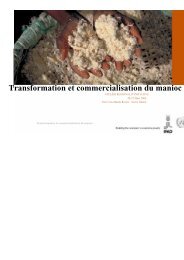Scaling Up the Fight Against Rural Poverty - FIDAfrique
Scaling Up the Fight Against Rural Poverty - FIDAfrique
Scaling Up the Fight Against Rural Poverty - FIDAfrique
You also want an ePaper? Increase the reach of your titles
YUMPU automatically turns print PDFs into web optimized ePapers that Google loves.
eminently well suited to move from a short-duration project approach to a longer-term programmatic<br />
approach that could support well-designed scaling up pathways. We understand that IFAD’s Executive<br />
Board expressed its dissatisfaction with <strong>the</strong> FLM soon after its introduction and <strong>the</strong> instrument has<br />
been in limbo since. The limited experience with FLMs should be reviewed and <strong>the</strong> option of<br />
reactivation seriously considered. During interviews a number of CPMs told us that <strong>the</strong>y would<br />
welcome this as a way support scaling up approaches.<br />
Budget support: IFAD traditionally has seen its core function in working with poor rural communities,<br />
often in remote or disadvantaged regions. In recent years, however, budget support has become an<br />
approach much favored by <strong>the</strong> donor community and by many recipient countries as representing an<br />
efficient and effective way for donors to support developing countries’ own programs. While IFAD<br />
recognizes <strong>the</strong> potential of budget support operations for influencing <strong>the</strong> broader budgetary allocation<br />
mechanism – and hence a way to scale up <strong>the</strong> impact of its own limited financial resources – it is<br />
concerned that this will remove it too far from its main role of on-<strong>the</strong>-ground engagement with poor<br />
farmer. Hence, IFAD has generally not provided budget support. 31<br />
Grant mechanisms: IFAD has long had <strong>the</strong> capacity to make grants in addition to loans. Grants have<br />
been made for research and innovation, for capacity building and for investment projects (in countries<br />
that cannot afford to borrow from IFAD). Recipients have typically been governments, research<br />
institutions and NGOs. A recent revision of IFAD adapted <strong>the</strong> policy to include explicit reference to<br />
support for scaling up. 32 The use of <strong>the</strong> grants instrument for this purpose could be reinforced by<br />
setting up a special grant window that would provide grants specifically targeted at scaling up of<br />
successful innovations or interventions. The new policy also stresses links of grants to country<br />
programs. To <strong>the</strong> extent <strong>the</strong> COSOPs increasingly reflect scaling up pathways, it would be desirable to<br />
give CPMs <strong>the</strong> freedom to apply grants in support of moving along <strong>the</strong>se pathways (through<br />
appropriate engagement with in-country partners, including communities, local authorities, research<br />
institutions, etc.). An especially good use of grants is through competitive allocation mechanisms.<br />
Such mechanisms can ensure not only more effective selection of recipients but also wider impact by<br />
providing incentives for improved institutional learning and performance. (Zinnes 2009)<br />
2. Operational modalities – from area-based to national and regional approaches<br />
IFAD’s traditional mode of operation has been area-based, i.e., focused on specific areas in a country.<br />
Over time it might expand <strong>the</strong> project into different areas or different target groups or <strong>the</strong>matic areas of<br />
engagement as a way to scale up. The Peruvian program, which we described in Chapter 3 above, is an<br />
example of scaling up in all <strong>the</strong>se dimensions. IFAD’s area-based approach remains its predominant<br />
modality in <strong>the</strong> larger countries due to <strong>the</strong> relatively small size of its projects.<br />
development objectives; an iterative, phased design process over <strong>the</strong> extended period of <strong>the</strong> loan to allow for<br />
greater flexibility in resource allocation and planning; a detailed design process for <strong>the</strong> initial cycle of project<br />
activities, with a set of clearly-defined pre-conditions, or ‘triggers’, for proceeding on to subsequent cycles; and<br />
an enhanced role for monitoring and evaluation (M&E) to ensure that <strong>the</strong> projects remain on-track in pursuit of<br />
<strong>the</strong>ir immediate and long-term objectives. Approval of <strong>the</strong> initial loan envelope, project objectives and technical<br />
approach will rest with <strong>the</strong> Executive Board, while <strong>the</strong> decision whe<strong>the</strong>r or not to proceed to subsequent cycles<br />
will be taken by IFAD management.” (IFAD, 1998, p. 1)<br />
31 Donors provide sectorally targeted budget support often in connection with “Sector Wide Approaches”<br />
(SWAps); however, SWAps can also be designed to incorporate donors who do not provide budget support,<br />
which allows IFAD to participate in SWAps where appropriate (see also next section).<br />
32 IFAD, “IFAD Revised Policy for Grant Financing”, PowerPoint Slides for Informal Executive Board Seminar,<br />
10 September 2009.<br />
39



